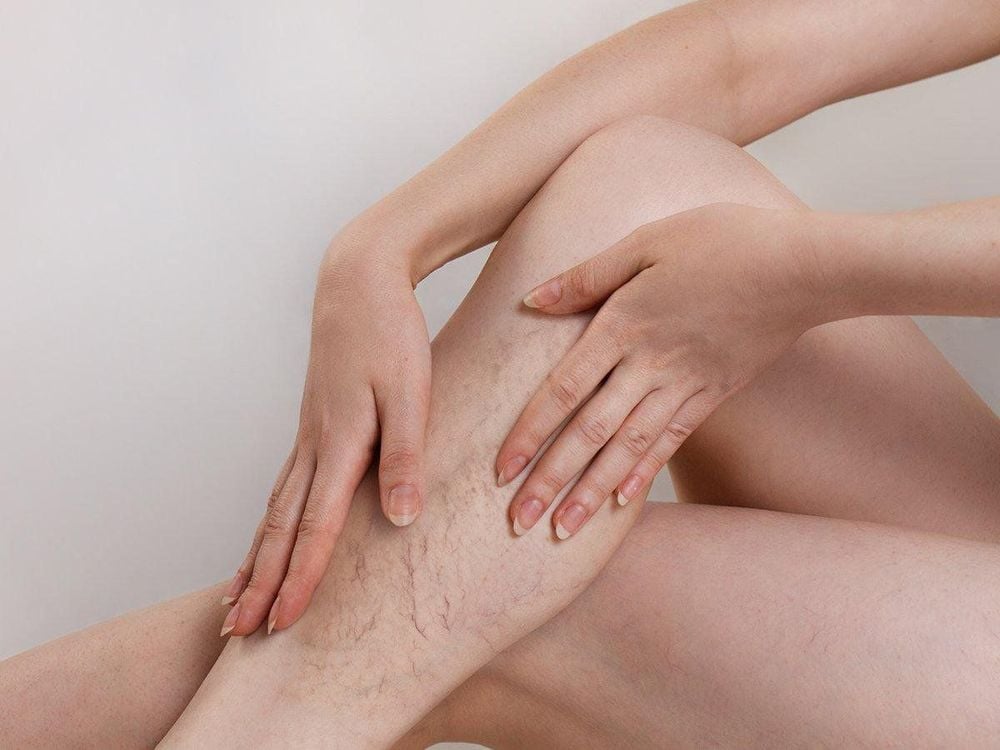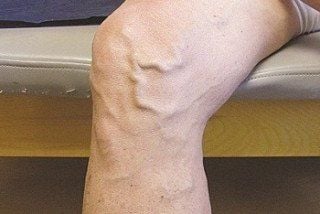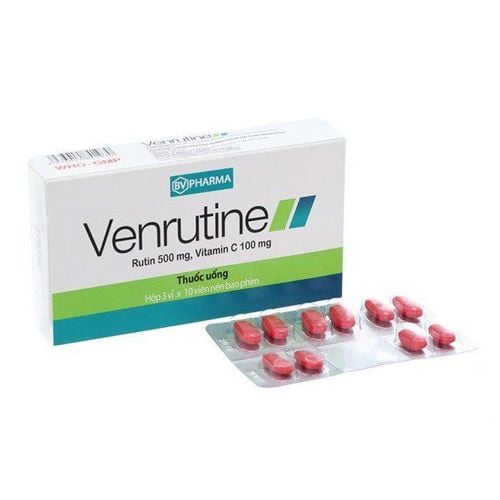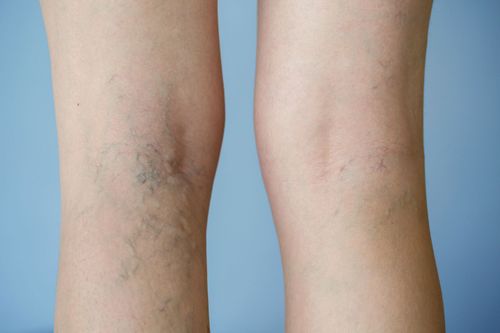This is an automatically translated article.
Varicose veins of the lower extremities are quite common today with an increasing incidence related to the lifestyle of the new society. Jobs that require workers to sit or stand for long hours, and increased obesity are risk factors for venous insufficiency of the lower extremities. So is it difficult to diagnose and treat varicose veins of the lower extremities?
1. Risk factors for superficial varicose veins
The prevalence of superficial varicose veins in adults in Vietnam is about 9 - 30%. The prevalence and increase of superficial varicose veins of the lower extremities have greatly affected the patient's ability to work and quality of life. The treatment of superficial varicose veins of the lower extremities should be focused to help patients improve symptoms, avoid late complications and improve working capacity. Risk factors predisposing patients to superficial varicose veins:
Increasing age: 50% of adults over the age of 50 have superficial varicose veins, this rate increases to 70% with superficial varicose veins. at the age of 70; Hereditary superficial varicose veins: the risk of developing varicose veins of the lower extremities increases 2 times if a patient has a parent with the disease, this risk increases 4 times if both parents have the disease superficial varicose veins ; Gender: Venous insufficiency of the lower extremities is 3 times more common in women than in men. This is explained by the effect of the hormones estrogen and progesterone on the walls of blood vessels in women and sedentary habits, some jobs require standing for a long time. Especially women have to go through the pregnancy, in the last months, the abdominal pressure increases, preventing blood from the veins returning to the heart, causing varicose veins before and after birth; A low-fiber diet, frequent constipation increases abdominal pressure when the patient uses force to push, a sedentary lifestyle, sitting/standing for a long time increases pressure on the veins; Body fat, obesity; Long-term immobilization in people with paralysis of the lower limbs, hemiplegia, quadriplegia... after pelvic or joint surgery or regularly using oral contraceptives will increase the risk of blood clots. deep veins, causing secondary superficial varicose veins.
2. Pathophysiology of superficial varicose veins
The blood vessel system in the human body is divided into 3 parts:
Arteries are responsible for carrying blood from the heart to the organs to nourish the body; Capillaries help with metabolism in organs; Veins are responsible for carrying blood back from the organs back to the heart. In which, the lower extremity vein system is divided into 3 main groups:
Deep veins: tibial veins, popliteal veins, femoral veins that transport up to 90% of venous blood flow of the legs; Superficial vein: the great saphenous vein and the small saphenous vein, which transport only 10% of the venous blood flow of the legs; Perforated veins: transport blood from superficial veins to deep veins. In the veins, there are always one-way valves, these valves are responsible for helping blood flow in the direction from bottom to top, from shallow to deep and to prevent backflow of blood. When these valves are weakened for some reason, then blood flow backs up and tends to pool in the lower legs, causing heaviness, numbness/edema, and varicose veins. farm.
Watch now: Surgery to treat varicose veins of the lower extremities

Suy giãn tĩnh mạch nông chi dưới là bệnh lý khá phổ biến hiện nay
3. Diagnosis of superficial varicose veins
3.1. Symptoms of varicose veins in the lower extremities
Varicose veins of the lower extremities cause pain, pressure, and heaviness in the legs when the patient is sitting or standing, the pain is reduced when the leg is raised or the patient uses compression stockings. However, it is important to distinguish pain due to superficial varicose veins of the lower extremities from pain due to musculoskeletal causes, and intermittent claudication in arterial disease. Swelling, fatigue in the ankle position; Itchy; Cramps at night ; Restless legs, restless feeling; On clinical examination, physical symptoms such as: edema, spider veins, superficial varicose veins, skin dystrophy, eczema, ulcers...
3.2. Clinical examination to help diagnose superficial varicose veins of the lower extremities
Ultrasound is a safe, effective, non-invasive diagnostic technique that helps evaluate both the deep and superficial venous systems. The common femoral and popliteal veins should be examined to ensure no obstruction and regurgitation.
When doing ultrasound, it is necessary to note 4 factors: image observation, ability to compress, venous flow including measuring reflux time and measures to increase flow.
Ultrasound in the standing position helps doctors assess venous valve failure in 1 of 2 ways:
Increase intra-abdominal pressure with the Valsalva maneuver: to evaluate the saphenous and femoral loops; Using manual pressure and release is often evaluated at long distances. Abnormal reflux time for the femoral and popliteal veins was greater than 1 second and in the great saphenous veins, the minor saphenous veins, the tibial veins, and the deep femoral veins were more than 0.5 seconds.
Patients with superficial venous insufficiency of the lower extremities should have careful transvaginal ultrasound examination, and perforation venous insufficiency is assessed when the superficial venous outflow is longer than 0.5 s, diameter ≥ 3.5 mm.
3.3. Grading according to the CEAP grading table
Grade 0: No signs of varicose veins (on visual or palpable); Grade 1: Have capillary dilatation or reticular varices; Grade 2: Varicose veins; Grade 3: Edema; Grade 4: Nutritional disorders of venous origin, skin pigmentation disorders, eczema... Grade 5: Nutritional disorders similar to grade 4 with healed ulcers; Grade 6: Nutritional disorder similar to grade 4 but with non-healing ulcers.
4. Treatment of superficial varicose veins of the lower extremities
4.1. Medical treatment of superficial varicose veins of the lower extremities
Intravenous drugs: diosmin, hesperidin, rutosides are the main active ingredients used in patients with pain and edema due to chronic venous insufficiency, combined with compression therapy. Pentoxifylline in combination with compression therapy increases the healing of venous ulcers.
4.2. Compression bandage treatment
Compression bandage in the treatment of superficial varicose veins of the lower extremities is an effective method to help control symptoms, but does not help to cure the origin of reflux. When patients with superficial varicose veins of the lower extremities have reflux, they should be treated with definitive methods.
Do not consider compression therapy as the first mandatory measure for pathological venous reflux when the patient is suitable for endovascular therapy. After interventional treatment, the doctor recommends that the patient should use a compression bandage in the postoperative period with the time and pressure decided by the doctor).
Venous insufficiency of the lower extremities is a chronic disease, so the patient is recommended to use compression stockings even after definitive treatment.

Xây dựng chế độ ăn uống cung cấp nhiều chất xơ để Xây dựng chế độ ăn uống cung cấp nhiều chất xơ, tránh tình trạng táo bón
4.3. Interventional treatment
Intravenous heat therapy: is the treatment of choice for saphenous and branch vein insufficiency. Intravenous heat therapy is contraindicated when no pulse is palpable in the feet, not in immobile patients, in poor health, with deep vein thrombosis, pregnancy, or twisted saphenous veins. can insert the catheter into the vein. Open surgery: indicated when the vein is not suitable for endovascular treatment, however, open surgery method is currently not recommended due to pain, long recovery time and many complications. Intravenous heat treatment procedure with Laser or Radio frequency:
Ultrasound in standing position to re-evaluate indications for endovascular intervention, venous mapping, venipuncture site; Patient lying supine, pain relief with intravenous Paracetamol; Sterilize the patient's legs with Betadin, performed in the groin area; Sterile sheets; Venous puncture by Seldinger method under ultrasound guidance; Insert the cauterization catheter to the position 1.5 - 2 cm from the saphenous vein loop; Perivenous anesthesia with ultrasound guidance; Conduct heat therapy (laser or RF) to destroy the saphenous vein stem; Other combined techniques (microscopic superficial vein removal).
5. Prophylaxis of superficial varicose veins
Avoid standing / sitting for too long, when lying down, raise your legs; Build a diet that provides plenty of fiber to avoid constipation; Regular exercise helps blood circulation to the heart better; During pregnancy, you should wear medical stockings to prevent superficial varicose veins; Lose weight to the most ideal weight for your height; For patients lying motionless for a long time should perform physical therapy, massage the extremities to avoid venous thrombosis. Varicose veins of the lower extremities are quite common today with an increasing incidence related to the lifestyle of the new society. Early diagnosis and treatment will help patients recover quickly.
The most serious complication of varicose veins of the lower extremities is the formation of thrombus in the lumen of the vessels, causing occlusion, the development of pigmented plaques on the skin and necrotic ulcers in the skin. In order to help customers effectively screen for this disease, Vinmec International General Hospital offers lower extremity venous insufficiency examination package, helping to determine the cause, complications and level of venous insufficiency.
When choosing to use the lower extremity venous insufficiency package, customers will receive:
Cardiology specialist examination (with appointment) Peripheral blood cell analysis (by laser counter) Glucose quantification Creatinine quantification Quantitative Pro Calcitonin Measure AST Activity (GOT) Measure ALT Activity (GPT) Quantify LDL - C (Low density lipoprotein Cholesterol) Quantify Triglycerides Quantify Cholesterol Electrolytes (Na, K, Cl) Normal Electrocardiogram Ultrasound heart, pericardium through the chest wall Straight chest x-ray Doppler ultrasound of the arteries and veins of the lower extremities (Vins of the lower extremities).
Please dial HOTLINE for more information or register for an appointment HERE. Download MyVinmec app to make appointments faster and to manage your bookings easily.













